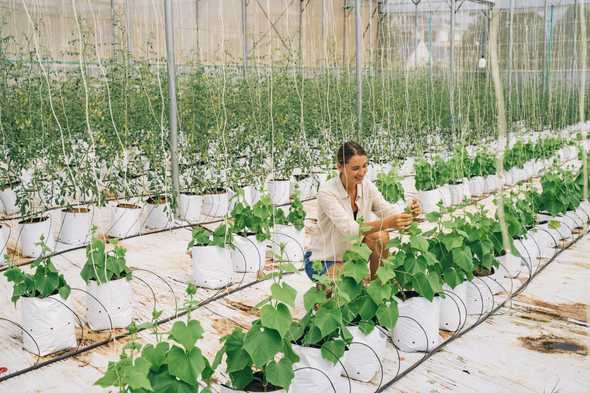Big farm with drip systems
Hydroponics can be practiced in many different ways, for example we have already introduced the ebb and flow system, the nutrient film technique or the deep water culture. One of the most popular of these systems is the so-called drip system. In the previously mentioned systems, the plant roots are usually standing or hanging completely in the water/nutrient solution. The drip system solves the nutrient and water supply differently.
How does a drip system work?
Drip System configuration with explanation
With the Drip System, each plant is supplied individually with water and nutrient solution. As usual, a reservoir with nutrient solution is provided. The distribution, however, takes place with hoses and so-called drip emitters. Each plant has its own pot and drip emitter, which ensures that the plant is supplied with sufficient water. Each Drip Emitter can be individually adjusted to regulate the amount of water supplied to the plant. The drip frequency should be adjusted so that the roots remain moist but are not overwatered.
The drip system is most suitable for larger plants that have more root mass but also require more space, making individual containers profitable. Other systems are based on plants sharing a container, which is obviously more suitable for smaller plants. With the drip system, the water supply of many plants becomes a little more complex, but this also allows them to have more space.
Drip Systems with and without recovery
There are 2 different types of drip systems, depending on whether the excess water from the plants is fed back into the reservoir or not. If there is no recovery of the nutrient solution, the excess water is lost, but the pH handling in the reservoir is easier, because no return water with changed pH is flushed back into the reservoir. However, if the excess water is collected and returned to the reservoir, the water loss is reduced, but the pH can also be greatly affected.
Non-recovery drip system configuration
Components
In principle, the components of a drip system are not very different from the components of other systems. Only the distribution of the water via hose lines is something special, in terms of components. Nevertheless, here is the list again.
Reservoir
The reservoir, analogous to other hydroponic systems, should be an opaque container large enough to supply the plants for a while. Opaque is therefore important to prevent algae from forming.
Pump
A sufficiently powerful pump is required to distribute the nutrient solution from the reservoir throughout the system. For larger drip systems, a pump with greater power is needed because the system may well consist of longer hoses with many distributors and drip emitters. In other systems, a natural flow of water often ensures that all plants are supplied with water. The pump in a drip system is usually still operated with a timer to schedule the water supply. Our HydroGuard is also perfect for scheduling and monitoring irrigation in a Drip System.
Air stone
To provide the nutrient solution with sufficient oxygen, you can install an air stone in the reservoir in addition to the pump, which will constantly bring fresh oxygen into the solution.
Distribution hoses
In order to transport the nutrient solution to each plant, you need sufficient distribution hoses, which are then laid from the pump to all plant containers. For drip systems, there are special systems with special manifolds or tools to connect and branch hoses.
Drip emitter
The last piece of the hose system at the plant container is then the drip emitter. This is a special end piece that regulates the flow to the plant. So depending on the preference of the plants, the right flow rate can be adjusted.
Plant container
The plant containers in a drip system are different from other systems if only because in other systems the containers are shared by many plants. Actually, any container which gives the plant enough room for the roots is suitable. the plant container should basically drain excess liquid so that the roots do not remain too moist. In a system with recovery, care must still be taken to ensure that the excess water is somehow collected and returned to the reservoir.
Medium
The plant reservoirs are filled with the growth medium. Analogous to other systems, all growth media are conceivable and usable here, such as: Rock wool, coconut fibers, clay balls.
Advantages of a Drip System
Tomatoes in a Drip System
- Delivers the water and nutrients directly to the plant
- Makes especially sense for larger plants that require more space
- Nutrient/water supply can be adjusted for each plant individually
- Reduces water loss
- Inexpensive and easy to install
- Confident in operation, system failure rare
- Irrigation can be easily controlled
Disadvantages of a drip system
- More material required than other systems, esp. the distribution hoses
- Clogging of drip emitters is a major problem
- Waste of water with non-recovering systems
Suitable plants for a drip system
The drip system is in principle suitable for large and small plants. However, it is more suitable than, for example, the NFT system for plants with many roots or a lot of space. Typical plants for drip systems are:
- Tomatoes
- Peas
- Cucumbers
- Zucchini
- Melons
- Onions
- Pumpkin
- Strawberry